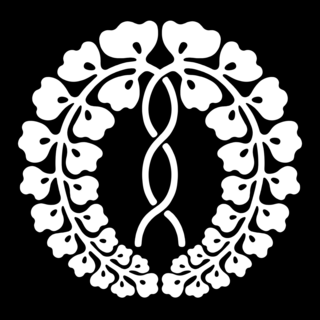Top Qs
Timeline
Chat
Perspective
Kujō family
Branch of the Fujiwara clan From Wikipedia, the free encyclopedia
Remove ads
Kujō family (Japanese: 九条家, Hepburn: Kujō-ke) is a Japanese aristocratic kin group.[1] The family is a branch of Hokke and,[2] by extension, a main branch of the Fujiwara clan.[3]
Remove ads
History
The family claims descent from Fujiwara no Kanezane, third son of Fujiwara no Tadamichi.[4] After the fall of the Taira clan in 1185, Kanezane became Sesshō and Kampaku with the support from Minamoto no Yoritomo;[5] Kanezane then founded an independent family as of 1191,[6] and the family name Kujō was named after a residence located on the road "Kujō-Ōji" (九条大路), where his family lived, built by his ancestor, Fujiwara no Mototsune.[7] Since then, the Kujō became one of the five Fujiwara families from which the Sesshō and Kampaku could be chosen, later known as the five regent houses.[1] The fourth and fifth shōgun' of the Kamakura shogunate, Kujō Yoritsune and Kujō Yoritsugu, came from this family as well.[8]
After the Meiji Restoration, members of the Kujō clan were elevated to princedom and given the title Prince.
Remove ads
Family Tree
Summarize
Perspective
| adoption | |||||||||||||||||||||||||||||||||||||||||||||||||||||||||
| Fujiwara no Tadamichi (1097-1164) | |||||||||||||||||||||||||||||||||||||||||||||||||||||||||
| Konoe family | |||||||||||||||||||||||||||||||||||||||||||||||||||||||||
| Konoe Motozane (1143-1166) | Kanezane(1) (1149-1207) | ||||||||||||||||||||||||||||||||||||||||||||||||||||||||
| Yoshitsune(2) (1169-1206) | |||||||||||||||||||||||||||||||||||||||||||||||||||||||||
| Michiie(3) (1193-1252) | |||||||||||||||||||||||||||||||||||||||||||||||||||||||||
| Nijō family | Ichijō family | ||||||||||||||||||||||||||||||||||||||||||||||||||||||||
| Norizane(4) (1211-1235) | Nijō Yoshizane (1216-1271) | Ichijō Sanetsune (1223-1284) | |||||||||||||||||||||||||||||||||||||||||||||||||||||||
| Tadaie(5) (1229-1275) | |||||||||||||||||||||||||||||||||||||||||||||||||||||||||
| Tadanori(6) (1248-1332) | Nijō Kanemoto (1267-1334) | ||||||||||||||||||||||||||||||||||||||||||||||||||||||||
| Moronori(7) (1273-1320) | |||||||||||||||||||||||||||||||||||||||||||||||||||||||||
| Fusazane(8) (1290-1327) | Nijō Michihira (1287-1335) | ||||||||||||||||||||||||||||||||||||||||||||||||||||||||
| Michinori(9) (1315-1349) | Nijō Yoshimoto (1320-1388) | ||||||||||||||||||||||||||||||||||||||||||||||||||||||||
| Nijō Morotsugu (1356-1400) | Tsunenori(10) (1331-1400) | ||||||||||||||||||||||||||||||||||||||||||||||||||||||||
| Nijō Mochimoto (1390-1445) | Tadamoto(11) (1345-1398) | ||||||||||||||||||||||||||||||||||||||||||||||||||||||||
| Nijō Mochimichi (1416-1493) | Mitsuie(12) (1394-1449) | ||||||||||||||||||||||||||||||||||||||||||||||||||||||||
| Nijō Masatsugu (1443-1480) | Masatada(13) (1440-1488) | Masamoto(14) (1445-1516) | |||||||||||||||||||||||||||||||||||||||||||||||||||||||
| Nijō Hisamoto (1471-1497) | Hisatsune(15) (1469-1530) | ||||||||||||||||||||||||||||||||||||||||||||||||||||||||
| Nijō Tadafusa (1496-1551) | Tsuneko | Tanemichi(16) (1507-1594) | |||||||||||||||||||||||||||||||||||||||||||||||||||||||
| Nijō Haruyoshi (1526-1579) | |||||||||||||||||||||||||||||||||||||||||||||||||||||||||
| Kanetaka(17) (1553-1636) | Takatsukasa Nobufusa (1565-1658) | ||||||||||||||||||||||||||||||||||||||||||||||||||||||||
| Yukiie(18) (1586-1665) | Takatsukasa Nobuhisa (1590-1621) | ||||||||||||||||||||||||||||||||||||||||||||||||||||||||
| Michifusa(19) (1609-1647) | Takatsukasa Norihira (1609-1668) | ||||||||||||||||||||||||||||||||||||||||||||||||||||||||
| Tokihime (d. 1669)[9] | Kaneharu(20) (1641-1677) | ||||||||||||||||||||||||||||||||||||||||||||||||||||||||
| Sukezane(21) (1669-1730) | |||||||||||||||||||||||||||||||||||||||||||||||||||||||||
| Morotaka(22) (1688-1713) | |||||||||||||||||||||||||||||||||||||||||||||||||||||||||
| Yukinori(23) (1700-1728) | |||||||||||||||||||||||||||||||||||||||||||||||||||||||||
| Tanemoto(24) (1725-1743) | Nijō Munemoto (1727-1754) | ||||||||||||||||||||||||||||||||||||||||||||||||||||||||
| Naozane(25) (1717-1787) | |||||||||||||||||||||||||||||||||||||||||||||||||||||||||
| Nijō Harutaka (1754-1826) | Michisaki(26) (1746–1770) | ||||||||||||||||||||||||||||||||||||||||||||||||||||||||
| Sukeie(27) (1769–1785) | |||||||||||||||||||||||||||||||||||||||||||||||||||||||||
| Suketsugu(28) (1784–1807) | |||||||||||||||||||||||||||||||||||||||||||||||||||||||||
| Hisatada(29) (1798-1871) | Takatsukasa Masamichi (1789-1868) | ||||||||||||||||||||||||||||||||||||||||||||||||||||||||
| Yukitsune(30) (1823-1859) | |||||||||||||||||||||||||||||||||||||||||||||||||||||||||
| Michitaka(31) (1839-1906) | Matsuzono Hisayoshi (1840-1903) | Tsurudono Tadayoshi (1853-1895) | |||||||||||||||||||||||||||||||||||||||||||||||||||||||
| Michizane(32) (1870-1933) | Tsurudono family | ||||||||||||||||||||||||||||||||||||||||||||||||||||||||
| Michihide(33) (1895-1961) | |||||||||||||||||||||||||||||||||||||||||||||||||||||||||
| Michihiro(34) (1933-2017) | |||||||||||||||||||||||||||||||||||||||||||||||||||||||||
| Michinari(35) (b. 1968) | |||||||||||||||||||||||||||||||||||||||||||||||||||||||||
Tsurudono family
The Tsurudono family (鶴殿家, Tsudono-ke) was founded by the fifth son of Kujō Hisatada, Tsurudono Tadayoshi (1853-1895), in 1888. The kanji used in the family name was originally "靏殿" but later changed to "鶴殿", both names are pronounced "Tsurudono".[11][12]
Remove ads
See also
References
Wikiwand - on
Seamless Wikipedia browsing. On steroids.
Remove ads

